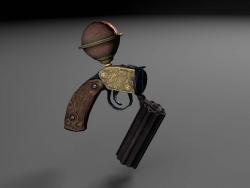Victorian Pepperpot Air Gun
Victorian Pepperpot Air Gun
This weapon is something of a hodge podge, the barrel and interior mechanism coming from a gun manufactured in 1781 and the body and grip dating from c.1830. While the pepper-pot barrel has been largely surplanted by the revolving cylinder, it is has found a resurgence amoung aethernauts where it's simplier design is slightly less inclined to fail.
The air gun has also found a permanent home in outerspace. Transportation costs have placed gun powder out of the budgets of all but the wealthiest of explorers. Whereas the tools and knowhow for handling compressed gases are a necessity for life in the aether. The terrestrial impact of pneumatic weaponry has been, for the most part, rendered obsolete by the power of gun powder, but in outerspace the effects of gravity are greatly reduced, and the resistence of air nonexistent.
This particular weapon has been fitting out to fire standard 18mm pneumatic fletchettes. It is top-break breech loading. As it is a refitted 18th century model, it is powered by Walden compressed air canisters. A conversion coupling is required to refill the canisters. One canister at full pressure is good for approximately 12 rounds, afterwhich muzzle velocity drops off rapidly. Walden canisters manufactured prior to 1824 are well engineered. Even after 70 or 80 years of use they can still be charged to full pressure with little concern for failure.
The firing mechanism is double action, a single pull on the trigger rotates the barrel and releases gas from the canister to launch the projectile.
The flechettes included with this gun have a conic butt for improved air drive and two-prong wire rifling trackers.
-------------------
The model includes diffuse, specular and normal maps at 1024x1024 (2048x2024 images can be made available). There is a great deal of detail in the brass and on the grip.
It is 1065 vertices (including fletchette).
The canister can be easily removed from the mesh of the gun.
The model has been rigged with constraints for operating the trigger, the barrel release lever, and the barrel break-action.
All textures are original and created by myself.











Comments
Wow! I am more in the 2d game thing - but this gun totally rocks! Very good work!
This is serious quality. Are all those details sculpted in 3D first or are you using another workflow for those intricate textures?
I create the designs in Illustrator.
I start by UVing the particular part of the hires model that the design will be applied to.
Then I use the UV as a template in Illustrator where I make the design as a height map.
I bring the Illustrator image into Photoshop by layers so that I can apply effects to further define the height (mostly inner and outer glows to increase the detail of the depth, details that would be painstaking to create in illustrator).
Then I run the Photoshop height map through CrazyBump to generate the normal map (before CrazyBump was available for OS X I would apply the height map to the hires model, but using the normal generated by CrazyBump produces better results).
I apply the normal map to the hires model and normal bake it to the lores model.
I also use CrazyBump to generate a number of other maps which I bake from the hires to the lores which I will use to aid me in building the diffusion map. For example, I'll generate a high contrast specular map with CrazyBump, bake that to the lores uv, bring the baked image into Photoshop, and use it to select the high points of the design. I can use that selection to add a look of wear or polish to the highest portions of the design.
Thanks for explaining with specific example images! The explanation is nearly as useful as the model itself.
I learned that I really need to add CrazyBump to my workflow. Seems like the best way to work on embossed or carved detailing.